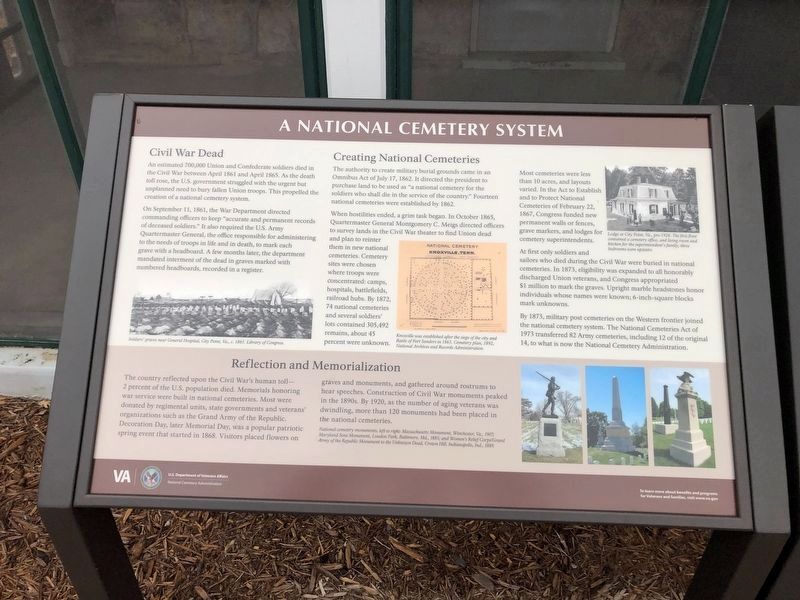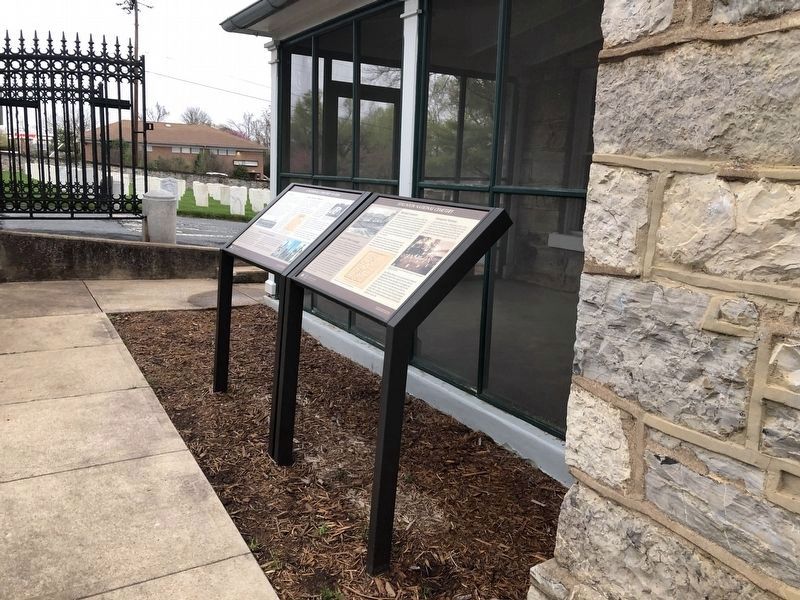Staunton, Virginia — The American South (Mid-Atlantic)
A National Cemetery System
Civil War Dead
An estimated 700,000 Union and Confederate soldiers died in the Civil War between April 1861 and April 1865. As the death toll rose, the U.S. government struggled with the urgent but unplanned need to bury fallen Union troops. This propelled the creation of a national cemetery system.
On September 11, 1861, the War Department directed commanding officers to keep "accurate and permanent records of deceased soldiers." It also required the U.S. Army Quartermaster General, the office responsible for administering the needs of the troops in life and in death, to mark each grave with a headboard. A few months later, the department mandated interment of the dead in graves marked with numbered headboards, recorded in a register.
Creating National Cemeteries
The authority to create military burial grounds came in an Omnibus Act of July 17, 1862. It directed the president to purchase land to be used as "a national cemetery for the soldiers who shall die in the service of the country." Fourteen national cemeteries were established by 1862.
When hostilities ended, a grim task began. In October 1865, Quartermaster General Montgomery C. Megis directed officers to survey lands in the Civil War theater to find Union dead and plan to reinter them in new national cemeteries. Cemetery sites were chosen where troops were concentrated: camps, hospitals, battlefields, railroad hubs. By 1872, 74 national cemeteries and several soldiers' lots contained 305,492 remains, about 45 percent were unknown.
Most cemeteries were less than 10 acres, and layouts varied. In the Act to Establish and to Protect National Cemeteries of February 22, 1867, Congress funded new permanent walls or fences, grave markers, and lodges for cemetery superintendents.
At first only soldiers and sailors who died during the Civil War were buried in national cemeteries. In 1873, eligibility was expanded to all honorably discharged Union veterans, and Congress appropriated $1 million to mark the graves. Upright marble headstones honor individuals whose names were known; 6-inch-square blocks mark unknowns.
By 1873, military post cemeteries on the Western frontier joined the national cemetery system. The National Cemeteries Act of 1973 transferred 82 Army cemeteries, including 12 of the original 14, to what is now the National Cemetery Association.
[Sidebar:]
Reflection and Memorialization
The country reflected upon the Civil War's human toll - 2 percent of the U.S. population died. Memorials honoring war service were built in national cemeteries. Most were donated by regimental units, state governments and veterans' organizations
Erected by U.S. Department of Veterans Affairs, National Cemetery Administration.
Topics and series. This historical marker is listed in these topic lists: Cemeteries & Burial Sites • War, US Civil. In addition, it is included in the National Cemeteries series list. A significant historical date for this entry is February 22, 1867.
Location. 38° 8.413′ N, 79° 2.992′ W. Marker is in Staunton, Virginia. Marker is on Richmond Avenue (Route 250) just east of National Avenue, on the right when traveling west. Touch for map. Marker is at or near this postal address: 901 Richmond Ave, Staunton VA 24401, United States of America. Touch for directions.
Other nearby markers. At least 8 other markers are within walking distance of this marker. Staunton National Cemetery (here, next to this marker); Address by President Lincoln (a few steps from this marker); Medal of Honor Memorial (a few steps from this marker); Veterans Memorial (a few steps from this marker); United States National Military Cemetery - Staunton (a few steps from this marker); First Settler's Grave (approx. 0.6 miles away); Avenue of Trees (approx. 0.6 miles away); The Virginia School for the Deaf and the Blind (approx. 0.9 miles away). Touch for a list and map of all markers in Staunton.
Credits. This page was last revised on November 8, 2021. It was originally submitted on November 8, 2021, by Devry Becker Jones of Washington, District of Columbia. This page has been viewed 102 times since then and 11 times this year. Photos: 1, 2. submitted on April 10, 2021, by Devry Becker Jones of Washington, District of Columbia.

